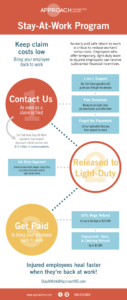Returning to work as quickly as possible is still the most important response to a workplace injury or occupational disease. That was the takeaway from last week’s Approach Brain Trust webinar, which looked at the continued importance of light-duty work in the time of COVID-19.
Getting doctor’s approval for return to work
The Activity Prescription Form (APF) holds the key to return-to-work. This is the document that the attending provider will complete in order to indicate if the worker can return to their usual job right away or if a period of light-duty work is required.
Double-checking the claim forms
Wendie Hunt Burgess, RN, retro coordinator at Approach, reminded employers that accuracy is critical when it comes to the APF. “Be sure to check the name on the APF to make sure it’s your employee,” said Hunt Burgess, “and that the claim number is also your company’s claim.” It’s true, when an employee has more than one job, employers have been known to receive APFs for the other job!
Getting light-duty approval
It’s a well-known problem that many providers will indicate no approved work on the APF, believing that the employer does not have any light-duty work for their injured employees.
It’s true, when an employee has more than one job, employers have been known to receive claim forms for the other job!
That’s why Sarah Crain, retro group lead at Approach, recommends having an Injured Employee Packet, complete with sample light-duty job descriptions. “If an injury happens, make sure the employee grabs the injured employee packet and heads to the provider right away,” said Sarah Crain. She also reminded employers that they can encourage the use of a designated provider, such as the nearest occupational health clinic, although employees can seek treatment at the provider of their choice.
Creating light-duty positions
With so many challenges around COVID-19, light-duty has provided a silver lining. “Many of the new positions that employers have needed to create in the past year, such as COVID-19 Officer, Distance Monitor, Health Screener, or Clean Tech, are also ideal light-duty positions,” said Crain.

Approach has catalogued these new positions and they are available in the client portal. Of course, your Approach retro coordinator can help you access and customize a description that will work for your injured employee.
As always, the best light-duty position is the one that fills a need for your company. “Include your supervisors and even your employees when creating light-duty jobs,” said Hunt Burgess. “Think about those back-burner projects that someone can perform in order to free up your other employees.”
Creating the job description
Once you have the APF, of course, you need to create a job description that fits your employee’s work restrictions. Hunt Burgess suggested making sure the description takes full advantage of what’s allowed on the APF. For example, she said, “If the provider allows a full forty-hour week, make sure you put forty-hours on the job description, even if you don’t have that many hours of work available.” This will allow the provider to approve a description for up to that amount of time. “You can use the job offer letter to specify less time (or work), but at least you have the providers approval for the most that’s allowed,” said Hunt Burgess.
Staying on top of the claim
Later in the webinar, we looked at what happens with claims that take longer to close. It’s important to ask for an updated APF after every provider visit but remember that L&I puts limits on their reimbursements. “Some providers will be reluctant to provide more than 6 APFs in the first 60 days, or 4 in the next days,” said Hunt Burgess, “because they’re not going get paid for those (due to L&I limits).”
Too many cooks?
Marie Vartanian, vocational specialist and retro coordinator at Approach, looked at the problem of multiple attending providers on a claim. “L&I accepts APFs from the primary Attending Provider (AP), but this can change during the life of the claim,” said Vartanian. Surgery is one example when the operating provider may take over primary duties on the claim. Another is on long-term claims, when one provider may leave, or the injured employee may simply change providers. “Let the L&I claim manager know if it’s appropriate to update the AP on the claim,” said Vartanian.
Learn more about light-duty
For workers’ comp claims in Washington state, the keys to successful return-to-work are:
- Review the APF restrictions
- Draft a light-duty job description
- Get provider approval
- Offer the job in writing
- File for Stay-At-Work benefits after your employee has been back in the light-duty position
You can learn more about light-duty from Approach or access the webinar materials (clients only). Remember to contact your Approach retro coordinator as soon as possible after a workplace injury so we can get a light-duty job ready for your injured employee.

